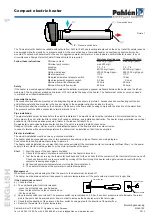
25
GAS CONNECTION
Connection of the heater to the gas supply, whether
Natural Gas or L P G , must be carried out in
compliance with the installation laws and by
qualified personnel. The warm air heater is factory
set to work with (G20) Natural Gas.
A (G31) Propane and (G30) Butane kits are also
available.
Before connecting the heater it is necessary to make
sure that.:
•
The correct type of gas for which the equipment has
been set up for is available.
•
The gas pipes are clean and free from debris .
•
The gas supply and meter are capable of delivering
the required volume of gas to ensure the correct
burner pressure can be achieved See TECHNICAL
DATA
•
The diameter of the pipework from the isolating cock
to the burner must not be less than the diameter of
the connection into the multiblock .
An approved gas jointing compound must be
used on all joints and unions and the system
purged and tested for soundness prior to final
connection
Gas Installation
1.
Threaded gas pipe connector
Male 1/2” BSP
thread on (type
1-2-3
) and 3/4” on (type
4-5-6
).
2.
Pressure stabiliser
* (Required to ensure
correct gas pressure at valve).
3.
Filter
* (Advised to prevent impurities which may
be present in the gas line from entering the gas
valve and also to permit simple inspection and
maintenance).
4. Isolating
Cock
*
: Each heater supply must be
fitted with a separate isolating cock
positioned adjacent to and upstream of the
union which must be sited outside the heater
the cock should be of the 90
0
turn type should
be clearly marked OPEN/CLOSED and should
be installed so as to fall to the closed
position.
5.
Gas pipe
*
(
*
) Customer Supply
WARNING!
When LPG supply is used
it is advisable to install a
first stage pressure reducer close to the LPG tank to
reduce the pressure to 1.5 Bar and a second pressure
reducer near to the heater installation to bring the
pressure down fron 1.5bar to 40 mbar max. A third
reducer (2) mounted in proximity to the heater ensures
the correct pressure is provided.
Note
To prevent any problems which could arise due toloss
of pressure it is advisable to install a minimum pressure
switch to shut down the heater in the event of gas
pressure failure.
WARNING!
As there have been recorded instances of the
deposition of copper sulphide dust within the valves and
orifices of gas appliances as a direct result of a reaction
between the hydrogen sulphide contained in some
natural gasses and copper pipe we recommend that the
heater(s) should not be connected to any natural gas
pipe distribution system which utilizes copper pipework,
including final connections. Instead steel pipework
should be used throughout.
In the event that it is impractical to use steel pipework
or where installers are obliged or insist on using
elements of copper pipework within the installation then
we strongly recommend that the gas supplier be
consulted as specific conditions and requirements may
be necessary.
















































